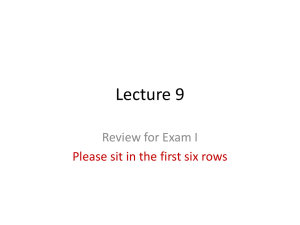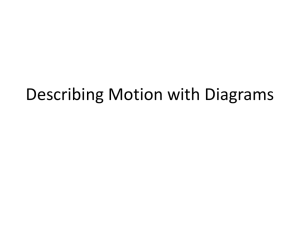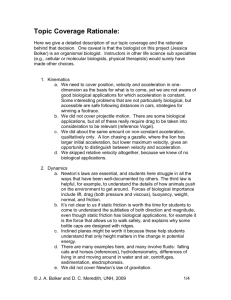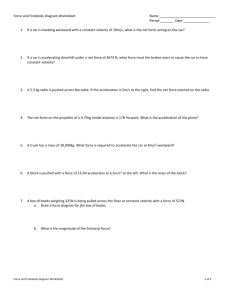Document
advertisement
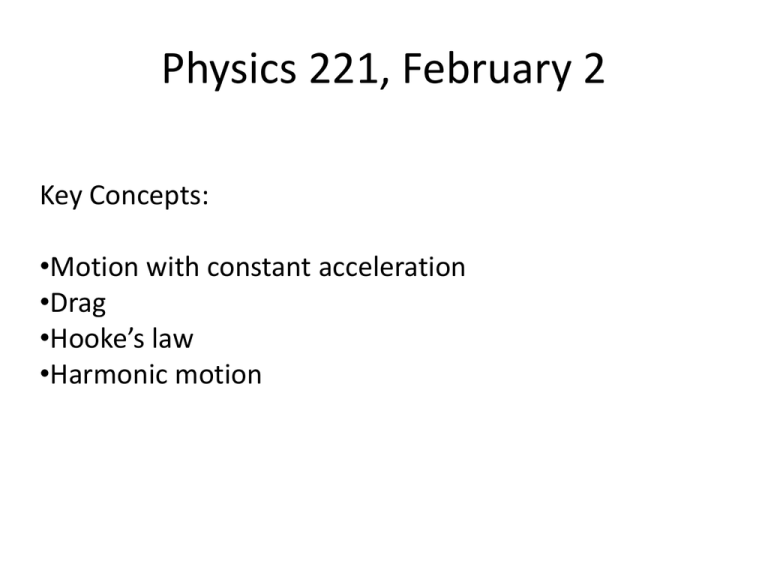
Physics 221, February 2 Key Concepts: •Motion with constant acceleration •Drag •Hooke’s law •Harmonic motion Electronic Devices Please separate your professional from your social life Do not use social media during class time. Physics Nobody can read it to you. You can only learn it by doing it. There are not that many things to remember. There are a few concepts that you must understand. You start to understand the concepts by applying them. • Observations and experiment • Questions • Problems It is usually not the answer itself that helps you understand the concept, but you questioning the answer. “What does that answer tell me?” “What does it mean?” Forces On macroscopic scale, the most common forces (interactions) we experience on a daily basis are gravity and contact forces. Gravity near the surface of Earth: • proportional to mass • constant as a function of position • pointing straight downward Fg = mg constant force constant acceleration Motion with constant acceleration in one dimension: Kinematic equations a = constant. vf = vi + a ∆t, xf - xi = vi∆t + (1/2)a∆t2, vf2 = vi2 + 2a(xf – xi). This includes a = 0. A gymnast jumps upward with an initial speed of 10 m/s. She is in the air for a total time of 1. 2. 3. 4. 5. 1s 2s 4s 0.5s 0.25 s 0% 1 0% 2 0% 0% 3 4 0% 5 30 Solution: At her highest point her velocity is zero. v = v0 – gt, let g = 10 m/s2. 0 = 10 m/s – gt, therefore t = 1 s is the time it takes her to reach her highest point. It takes her the same amount of time to come back down, so she is in the air for 2 s. or Her final position is equal to her initial position. xf – xi = v0t - (1/2)gt2 0 = (10 m/s) t - (1/2)gt2 gt = 20 m/s, t = ~2s, she is in the air for ~ 2 s. A particle is moving with velocity v = 60 m/s at t = 0. Between t = 0 and t = 15 s the velocity decreases uniformly to zero. What was the acceleration during this 15 s time interval? 1. 2. 3. 4. 5. 4 m/s2 8.6 m/s2 0.53 m/s2 -0.27 m/s2 -4 m/s2 0% 1 0% 2 0% 0% 3 4 0% 5 30 Solution: Since the velocity decreases uniformly, the acceleration is constant. We therefore have a = (vf – vi) /(tf – ti) = (0 m/s – 60 m/s)/(15 s) = - 4m/s2 Which position versus time graph does NOT represent motion with constant acceleration? 1. 2. 4. 5. 3. 0% 1 0% 2 0% 3 0% 4 30 0% 5 Extra Credit: Look at the plots of position and velocity of a falling ball as a function of time, similar to those obtained in lab 3. The same data points are represented to the right in a plot of velocity versus 1. 2. 3. acceleration. position. square root of time. 30 0% 1 0% 2 0% 3 A rock is thrown downward with an initial velocity of 10 m/s from a height of 30 m above the ground. How long does it take the rock to fall the last 10 m before it hits the ground? How do you solve this problem? Solution: • Find time for the rock to fall 30 m. • Find time for the rock to fall 20 m. • Subtract t(30 m) – t(20 m) to get time to fall the last 10 m. Let g = 10 m/s2. 30 m = (10 m/s)*t + ½ (10 m/s2) t2 5t2 + 10t – 30 = 0, t2 + 2t - 6 = 0. t(30 s) = [-1 + sqrt(7)] s = 1.65 s 20 m = (10 m/s)*t + ½ (10 m/s2) t2 5t2 + 10t – 20 = 0, t2 + 2t – 4 = 0. t(20 s) = [-1 + sqrt(5)] s = 1.24 s t(30 m) – t(20 m) = 0.41 s Contact forces: pushes, pulls, friction, drag Friction and drag are forces that always points in a direction opposite to the direction of the velocity of the object. They reduce the speed of the object. The magnitude of drag force increases with the speed. An object acted on by a constant applied force and drag will reach terminal velocity. The net force on an object can be zero, because the vector sum of the forces acting on different parts of the object is zero. The material then is under tension or compression. It expands or contracts. No material is perfectly hard. As long as the external pushes or pulls are not too strong, the contraction or expansion is proportional to the magnitude of the pushing or pulling forces. The material pushes back with force Fext = kx F = -kx This is Hooke’s law. Please understand that Hooke's law is NOT a law of nature. It is a rule of thumb that is often holds over a limited range of expansion and contraction. Harmonic motion If the only force acting on an object with mass m is a Hooke’s law force, F = -kx then the motion of the object is simple harmonic motion. With x being the displacement from equilibrium we have x(t) = Acos(ωt + φ) v(t) = -ωAsin(ωt + φ), a(t) = -ω2Acos(ωt + φ) = -ω2x. ω = sqrt(k/m) = 2πf = 2π/T. In terms of k and m: A = amplitude ω = angular frequency f = frequency T = period φ = phase constant Extra Credit : You have always wondered how much one of your friends weighs and devise a scheme to measure his weight secretly. You have him sit in a tubular steel chair. This popular style of chair consists of a single steel tube that is bent into a frame and that supports a seat bottom and a back. The empty chair weighs 10 pounds and is 30 inches tall. The frame acts as a spring and bends downward slightly when the chair is occupied. When you sit properly in the chair yourself, it bends downward 1 inch. When your friend sits properly in the chair, it bends downward 2 inches. From that observation, you know that your friend weighs about 1. 2. 3. 4. 5. 200 pounds. 150 pounds. four times as much as you. twice as much as you. one half as much as you. 0% 1 0% 2 0% 3 0% 4 0% 5 30 Extra credit: Demo: Measure the frequency or period of a 0.02 kg mass oscillating on a spring. What is the spring constant of this spring? 1. 2. 3. 4. 5. ~0.65 N/m ~0.95 N/m ~3 N/m ~6.5 N/m ~80 N/m 0% 1 0% 2 0% 3 0% 4 0% 5 30 Position, velocity and acceleration of an oscillating mass on a spring are shown as a function of time. What is the period of the oscillations? 1. 2. 3. 4. ~1.5 s ~2.5 s ~4 s ~0.4 s 0% 1 0% 2 0% 3 0% 4 30 Extra Credit: Position, velocity and acceleration of an oscillating mass on a spring are shown as a function of time. If the mass is 0.5 kg, what is the spring constant in N/m? 1. 2. 3. 4. ~6 ~3 ~1 ~0.5 0% 1 0% 2 0% 3 0% 4 30






